Suggestions for trees along privacy fence (PICS)
We are looking to add some additional privacy screening along our cedar fence in our backyard.
We are in Fairfield County, CT. Zone 6.
As you can see from the pictures, when we are sitting on our deck, we look right at the front stoop and side windows of our neighbors.
It is a somewhat narrow area. From the deck to the fence, it is about 17' wide. So we would prefer something that is not fat at the bottom, skinny at the top (like a spruce or hemlock). A fat bottomed tree would take up too much space between the fence and deck.
We are looking to add some trees that would provide privacy ABOVE THE FENCE LINE.
Evergreens would be great, but not sure if that is possible. But we would be fine with non-evergreens, because there would be coverage during the spring/summer/early fall months(which is when we typically use the deck). During the winter months, the branches, I guess, would provide some minimal screening.
Any ideas or suggestions would be great.
Thanks in advance.
Here are the pics:
View from the deck....The white railing in the distance is the neighbor's front door:
{{gwi:45077}}
{{gwi:45078}}
{{gwi:45079}}
{{gwi:45080}}
{{gwi:350333}}
Comments (48)
iforgotitsonevermind
15 years agoThat actually looks like a good site for a few magnolia grandifloras (southern magnolia) as they're evergreen and make a good screen but look nice limbed up as a canopy shade tree. It also looks like a fairly protected site which it will need to be for z6, although if that is the southern side of your property then you will sacrifice the energy savings of having that sun in the winter. But man oh man that will be so nice in summer sitting on that deck while the magnolias are in bloom. The flowers are show and fragrant. I might put them closer to the fence so that about half the canopy will be over the neighbors yard.
iforgotitsonevermind
15 years agoA couple of deciduous options would be european hornbeam which is very densely branched and makes a nice screen even with no leaves. ITs a great long lived tree but aside from that not all that interesting.
You might also look at katsura which is pretty dense too and leaves out very early. They get tall but not so wide. MAybe 20-30'Related Professionals
Camas Landscape Architects & Landscape Designers · Rossville Landscape Architects & Landscape Designers · Roxbury Crossing Landscape Architects & Landscape Designers · Bound Brook Landscape Contractors · Kearny Landscape Contractors · New Berlin Landscape Contractors · Secaucus Landscape Contractors · Vineyard Landscape Contractors · Shafter Landscape Contractors · Highlands Ranch Siding & Exteriors · Manassas Siding & Exteriors · Southampton Siding & Exteriors · North Reading Siding & Exteriors · West Hills Decks, Patios & Outdoor Enclosures · Immokalee Stone, Pavers & Concretebrandon7 TN_zone7
15 years agoI know this sounds pretty negative, but I really don't like those choices. I'd go to my local nursery, describe the site to them (they should already be familiar with your climate, soil, etc.), and see what they recommend. In my opinion you are going to need something very narrow and tall. If you only have 17' you're probably not going to want anything that gets more than about 10' wide. Maybe you could find something that you could limb up to clear the deck area, but I think too much foliage is going to close in your deck so much that it won't be enjoyable in a few years. I'd want sun to reach my deck, especially in summer, and I'd want plenty of room to walk between the deck and the trees.
brandon7 TN_zone7
15 years agoOh yeah, it looks like you are also going to need something that can grow in sun or shade because the area you'll need to block appears to have a little of both.
iforgotitsonevermind
15 years agoI don't mean to sound negative either but one of my biggest regrets with my current yard is planting narrow growing trees and small trees when what I really needed was more shade and more privacy of a larger tree. A trip to the local nursery is worthwhile but I would urge you not to buy on the first visit. Nurseries almost always try to sell you what they have in stock whether it's an ideal choice or not. And in this economy many nurseries are only carrying the basics like bradford pear and silver maples which are not good trees. Research the trees they have before buying.
stimpy926
15 years agoGoing back to the evergreen Magnolia idea, you could consider Magnolia grandiflora 'Teddy Bear', which is a smaller selection, growing to approx. 12' wide at maturity.
For deciduous, consider native tree, an Amelanchier, Serviceberry{{gwi:2101764}}
info:
Here is a link that might be useful: Magnolia g. 'Teddy Bear'
mrmichaeljmoore
Original Author15 years agoMy landscaper friend (who will be doing the planting of the trees) recommended the Cleveland Pear tree.
I guess the Cleveland pear doesnt have the problems of the Bradford Pear.
My wife likes the white spring blooms and the red fall leaves of the Cleveland Pear.I am gonna mention to him the Magnolias...
Looked into the Hornbeam, but they seem to be more expensive than the Cleveland Pear. Plus the flowers on the Cleveland are nice.
Question: Does anyone think the Cleveland Pear will provide at least some minimal screening during the winter months? Is the branch structure thick enough to a kteast provide a bit of cover?
thanks.
sea_dragon
15 years agoHere are some pics of my backyard that I finished off last year. I used 5 columnar maples along the back to block the huge house behind me and 8 Emerald Green Arborvitae. These trees provide very nice privacy and look really good IMO. Plus, they don't take up a lot of space horizontally.
{{gwi:2101765}}
{{gwi:2101766}}
{{gwi:2101767}}mrmichaeljmoore
Original Author15 years agoSea Dragon --
Thats a real nice job.
My wife is not a big fan of the arborvitaes.....
One other issue I have with the Arborvitae is that we have some deer in the area. Apparently, they will eat up the arborvitaes.....to the point where they will be bare from 6' down.thanks.
iforgotitsonevermind
15 years agoHELLL NO!
You do NOT want cleveland pears. Do not listen to your landscaper he wants to plant cheap junk that self destruct and split apart.Hornbeams are more expensive and that's because they are slow growing. But along with that slow growth comes a very long lived tree with strong wood. It wouldn't be my first choice for that site because I think you need something bigger and faster but not something that is going to send branches down on your head while you're sitting on the deck like the flowering pears.
Iris GW
15 years agoOrnamental pears are stinky! 'Cleveland Select' that close to the house would make me miserable.
You do have quite a bit of competition there from other mature trees - something to consider in terms of both available light and the overall look.
The red maple cultivars and hybrids are fairly fast growing and have beautiful color - 'October Glory', 'Autumn Sunset' and the hybrid Freeman maples.
Here is a link that might be useful: Freeman maples
brandon7 TN_zone7
15 years agoI agree with iforgotitsonevermind. If a landscaper recommended Cleveland pears to me, I'd smile, shake his hand, and NEVER EVER LISTEN TO ANOTHER WORD HE UTTERED ABOUT LANDSCAPING! Maybe others will feel differently, and maybe the trees do OK in some areas/situations, but that's what I'd do.
mrmichaeljmoore
Original Author15 years agoFrom my research, and correct me if I am wrong, I thought the Cleveland Pear didnt have the issues of other pear trees.
No pungent odor from the blooms
No splittingI thought the Bradford pear was the "bad" tree......
sea_dragon
15 years ago'From my research, and correct me if I am wrong, I thought the Cleveland Pear didnt have the issues of other pear trees.
No pungent odor from the blooms
No splittingI thought the Bradford pear was the 'bad' tree...... '
I got the same impressions from my research last year and I planted a Chanticleer in my yard. Here is but one of the articles I read...
Here is a link that might be useful: Callery Pear
mrmichaeljmoore
Original Author15 years agoSea Dragon --
I think the Chanticleer and Cleveland are the same thing.
just different names for the same tree.
At least thats what I have read on other GardenWeb posts....iforgotitsonevermind
15 years agoThere's a saying, "You can't polish a turd" well that's pretty much how it goes with callery pears. They slightly improved the tight "crotch angles" but they are still weak wooded, their early leafing canopies catch the wind in spring storms too. Their flowers still smell bad. They may last an extra couple of years but the bottom line is they aren't a good tree. And in many places they are also an invasive species and I can tell you first hand I am noticing them spread into forests and displace threatened plants and wildlife.
I've also noticed that this year, I've seen more callery pears on sale than ever before. They're so cheap to produce that landscapers can make it seem like a bargain to use them because they cost so much less than more desirable trees. In this economy that means a better chance of making the sale. So these problems we complain about are problems that aren't going anywhere soon.
mrmichaeljmoore
Original Author15 years agoMan......there are some really strong opinions about pear trees on the Garden Web........
wow....
sea_dragon
15 years agoStrange... I live in Guelph, Ontario, Canada and our city is known for it's agricultural heritage. The University of Guelph specializes in and offers many specialized courses in agriculture and the Ontario Ministry of Agriculture has a large office here.
There are a large number pear trees planted in public spaces all over Guelph and the city keeps planting more, especially along roadways and boulevards. From some postings I've read in various threads on this forum, it makes it sound like pears are the Antichrist. Are they really that horrible? And if so, why would they keep planting them along streets if they supposedly break so easily?
I'm confused.
ken_adrian Adrian MI cold Z5
15 years ago"You can't polish a turd" -- actually they recently did on mythbusters.. go figure on that ..
i have a cleveland select... horrible smell ... thank god it 100 feet out in the yard .... and therein lies the key .. a place for everything.. and everything in its place ... put one on the golf course.. it will be glorious ... put it in your little placement.. you MAY regret it ...
there is ALWAYS.. the new and improved version ..
i simply ask.. if they had to improve it.. why bother with it ... improved or not ...
you only have a couple million options other than a pear ... so why go with it????
there were hundreds of cities and professors over the years.. that thought the flowering pear was the be all and end all .. and now.. decades later ... we know better ..
i dont care what they say ... you can do better ...
there are fastigate forms of picea pungens [blue spruce] and hollies ....
too bad about the hatred of thuja [arbs] ... good luck
ken
stimpy926
15 years agoYou're just hitting a sore spot with everyone here when bringing up Callery pears. They're still commonly recommended because they're very tough, can withstand a lot, but this is your yard, and because there's better things to plant. Believe us when we tell you that you will not want to sit on that deck when the tree blooms.
Please don't go for the cheap. It's your yard, care about it. Isn't it true, as in other parts of life, you're glad down the road, that you paid for a better item?
Amelanchier varieties
Magnolia virginiana
Chionanthus virginicus
Oxydendron arboreum
Viburnum prunifolium , yes it's a small treeI posted again earlier but it didn't go through. Forget 'Teddy Bear' Mag., but 'Little Gem' is more hardy, smaller, and evergreen. It grows well here in Z6, also at Chanticleer. It may be hard to find, but Connect. has a lot of specialty nurseries. It would need 6 hours min. of sun
Here is a link that might be useful: Mag. grandiflora 'Little Gem'
brandon7 TN_zone7
15 years agoYou'll find opinions on both sides almost everywhere you look. Some parts of the country seem to have better luck with callery pears than others. People that sell them always seem to have a much higher opinion of them than people concerned about their impact on the environment or people who've had bad experiences.
Clevelands are somewhat less likely (not immune) to splitting and breaking apart with age, they show just as much invasive potential as Bradfords, and callery pears, as a group, are way overplanted. Some sources list 'Cleveland Select' as completely sterile. These sources are either misinformed or are simply refusing to admit reality.
Planting a Cleveland pear might not be the worst decision you could make, but I don't think it would be the best either. I believe any professional landscaper recommending these, for almost any situation, is suspect. If they are familiar with all the other choices, I don't know why they would recommend planting Clevelands unless that's what they had to sell at the time.
mrmichaeljmoore
Original Author15 years agoWell, my landscpaer is trying to do his best by keeping my costs down but still accomplish the task of screening.
We are hoping to get some immediate screening which obviously drives up the price as the trees are bigger.
So, with the goals of immediate screening effect, fast growing trees, aesthetically pleasing to the eye, and low price, my landscaper seems to think the Cleveland pears provide best "bang for the buck."
Someone in an earlier post mentioned earlier about spending a bit more money for a better item is better in the long run. I agree with this statement, but unfortunately the checkbook dictates how much we can spend....and our budget is tight right now.
I do apprecite everyone's comments....they have been very helpful.
I plan on stopping by another nursery on the way home.
The last time I was there, one of the guys recommended Linden trees. Hopefully I get a different guy and see what he recommends. I'll let you know.What do people think of the Linden tree?
Iris GW
15 years agoWe have very few Lindens in Georgia so I can't comment. If you want to research more, Tilia is the genus name for Linden.
Keep in mind that you do have an adjacent fence and any trees which are prone to breakage could do damage to that fence, causing you money later to repair it.
I do agree that ornamental pears are overplanted and overrated. Here in the southeast they have become invasive due to cross pollination (sterile 'Bradford' planted with a mile or so of a sterile 'Cleveland' will results in both of those sterile trees setting viable small fruit). Of course not everyone cares what happens outside their backyard, but I do and these plants are seeding into natural areas (I pull them out on a regular basis thanks to my neighbor's one tree).
I do think that if he would price out some red maples, you'd find them to be comparable in price.
Don't think you need to get the BIGGEST plant you can afford. It has been demonstrated that smaller trees recover from transplanting faster and catch up in growth rate with the big ones.
stimpy926
15 years ago3 years at least, for a large, more expensive tree to start growing after settling in. In the meantime, a small, less expensive one has been growing and will be close in size to the big one, when it was planted. You're going to be waiting either way.
Buy choice, smaller, use the extra $ to construct a summer screen with morning glories as Ken suggested, or plant tall summer easy annual such as Ricin, Castor Bean plant, next to the deck.
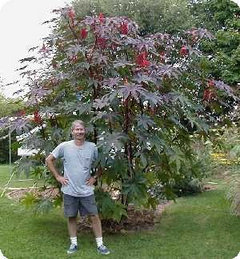
iforgotitsonevermind
15 years agoYeah. The pears will give you a bang alright. In the middle of the night if you're lucky, and it will cost thousands to remove and repair the damage to your deck and neighbors fence.
Lindens are nice trees but they attract bees when in bloom. They go into bloom at times you will want to use the outdoor space.
They are also wider at the base, a pyramidal shape which you expressly said you do not want. Please just fire that landscaper. They don't know what they're talking about.
Lacebark Elm might be the answer. They grow fast but are desirable and some varieties have an upright vase habit. They leaf out early and drop leaves fairly late. I still think you'd be happier with southern magnolias but they are expensive and I'd imagine they are not very easy to find in new england.
stimpy926
15 years agoAgreed, don't listen to someone who's not devoting the time that you hopefully are, before making a big decision. He's not paid for that time to really think it through is he?
Linden's also get chewed by japanese beetles.
Still strongly suggest Amelanchier, or Viburnum prunifolium, Natives, as suitable alternatives to Callery Pear.
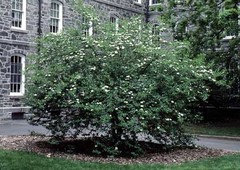
Here is a link that might be useful: Viburnum prunifolium
arktrees
15 years agoIlex decidua "Winterberry". There are yellow, and very red cultivars (but you will need a male to pollinate for berries), and native. Grows in most any soil, wet/dry, sun/shade, to a small tree, and retains berries for color over-winter. These berries then feed migrating birds the following spring. Should not be all that expense, though you might have to order from online to get what you want.
Arktrees
siennact
15 years agoI have a similar situation and I decided to go with a five year plan...
Choose the "goal" screening plant that will take a few years to do its job, like a large tree. Put this out by the fence and let it get started growing.
In the meantime, grow vines on the fence or fast growing bushes or annuals NEAR THE DECK to provide temporary relief. Another option might be to plant fast-growing trees that you are willing to sacrifice in a few years when they become problems (as many fast growing trees do).
Lindens are nice but mine attracts every Jbeetle in Connecticut. Other trees I chose for fast growing and dense leaves are a katsura tree and a stewartia, neither has bugs or disease issues (knock on wood).
kimcoco
15 years agoHey, I remember you posted something similar awhile back.
If you don't want the width of evergreens at the bottom, you can still trim the bottom of the evergreens up to the height level with the top of the fenceline.
Why not?
mrmichaeljmoore
Original Author14 years agoOriginal poster here.....update....
Well, my wife and I have been continuing our research before we decide on which trees to plant, including visiting several local, well-respected nurseries in my area (Fairfield County, Connecticut).We visited 5 local nuseries, all of whom have been in business for a long time.
I brought the pictures I posted above and showed them to the landscape design folks at each of the nuseries.
WITHOUT FAIL, ALL of the nurseries recommended the pear tree as a good possibility. For some of them it was the first suggestion out of their mouth! Now, please don't misunderstand me, they also recommended other trees during our discussions, but ALL of them said the pear tree is a good choice for my application.
Like I said, they did suggest other options, such as columnar hornbeam, Green Pillar Pin Oak, Eastern Pansy Redbud, Thundercloud Purpleleaf Plum, and all sorts of different cherry trees (Okame, Quantum, Kwanzaan). But the common suggestion among all he nurseries is the Pear.With all of the negative info on gradenweb about the pear, it is VERY frustrating as a homeowner who knows absolutely nothing about trees (except for what we've read about since we beagn this adventure) to go to local well-respected nurseries and have them tell me that pears are a good tree.
A couple nurseries did concede that pears can be prone to breakage, but they said not as much with the newer varieites; that was more prone to the Bradofrd. In fact, one nursery has a pear (not sure which kind) that is over 20+ years old right in the front of their store entrance.Man, this is frustrating. I know the nurseries are in business to sell trees.....But why would they sell something that is apparently so despised in the landscaping world. Why would they sell something that people wont like cuase of the smell or might die/break before it's useful life is over? Wouldnt that be bad business? Wouldnt word get around that this nursery sells crappy trees?
I dunno.....just real frustrating. I mean after all, it's just a few trees. This purchase has been more frustrating than buying my friggin house!
jm30
14 years agoI can understand your frustration, but I would most definitely stay away from any type of Callery pear (Bradford, Cleveland, Aristocrat, New Bradford). I would no longer listen to any advice from anyone that would recommend this tree. In my area, I rarely see a nursery that even sells them. Sure, you'll occasionally come across one that grows big and never causes any problems. But the percentage of those that get destoyed and destroy property with it is way too high to take a chance. This past winter, we had an ice storm here in Ky, and I promise you, every Callery Pear (Bradford or Cleveland) that was more than 10 or 12 years old in my neighborhood got destroyed. Half or 3/4 of the tree splitting off and laying on cars, decks, and houses. I'm not exaggerating, every single one. I've seen numerous ones fall just from common thunderstorms in the summer also. Drive around your local area, and see if you can find some that are 20' or taller and see if you can see big chunks of the tree's canopy missing. Also, like everyone else mentioned, the flowers stink and would be a mess all over your deck. Plus they are so invasive, they're easy to spot in the spring when they are flowering. Drive down the interstate and look at the natural areas alongside the road and I promise you, you'll see large groves of white flowered trees taking over the area.
Regarding the any type of plum tree, if you have Japanese Beetles in your area, they will destroy it. That is one of their favorites, I've had one before and the beetles could completely defoliate it within 2 days. Nothing I tried would barely hinder them. I finally removed the tree.
I think redbuds would be nice there, either eastern or forest pansy. They like a little protection from wind and some dappled shade and your site looks like it has it. Amur maple might be another option, multi-stemmed, somewhat smaller maple with nice fall color. I also think a black tupelo (black gum) would work there. Those would get the size you want, but they are somewhat slow to moderate growers.
If those options are more than you want to pay, simply go with a good maple tree. Like October Glory. Medium sized trees, nice form and excellent fall color. Now it will eventually hang over part of your deck, which is fine with me cause I like sitting in shade instead of sunbathing, but that's your preference. No need to get big specimens, 6' would be fine cause they grow moderate to fast.
All of these trees are basically "little maintenance" trees once established. There's nothing I dislike more than a tree I have to constantly pamper to keep the bugs and diseases off.iforgotitsonevermind
14 years agoThat *IS* frustrating.
I can understand how you wouldn't know who to trust.
Don't take our word for it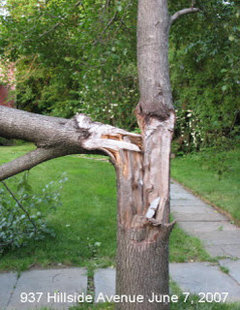
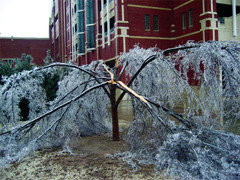
Invasive callery pears taking over natural areas
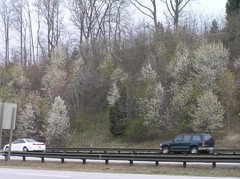
stimpy926
14 years agoDo the words "I want a tree that will grow, and I don't want to have to take care of it" mean anything? Or "...plant something that won't die on me".
Or these words "...I don't want to see this client coming in next year telling me he wants a replacement for his dead tree."
Pears and plums are tough, and they will grow just about anywhere, hence the overplanting of them.
We're not advocating difficult to establish trees in our suggestions. A pear would probably survive if you water it once. Any other offer considered would take some devotion from you to get it established. If you are serious about taking care of a good plant, then persue what you like. Google the heck out of it and go for it. Otherwise, plant something easy and tough, to fill the space between you and the neighbor.
stimpy926
14 years agoGoogle the heck out of it...and by all means post back here for continuing care questions :-D
arktrees
14 years agoI agree with the redbuds, Grow fairly quickly, and won' break the bank. Another possibility is something really crappy, cheap, short-lived anyway like a Lombardy Popular that you know you will take down in 5-10 years and won't mind doing so but will give you a screen quickly. In the intervening time you plant something that is a bit slower to take their place when the LP's are removed (before they get too big, difficult and expensive to remove). I would probable take the later approach as I'm impatient, the the LP's would provide a screen in just a couple growing seasons. I don't much like them, but they are tough and can serve a purpose as described above. But beware they don't have fall color, no nice flowers, and don't have a pleasant smell (not really a negative smell unless smelling a new growing tip which kinda stinks), and they can sucker from roots. Their primary attribute is fast growth in a column that can be utilized short term.
Arktrees
mcmann
14 years agomrmichaeljmoore-
It's now the middle of July and I was wondering what you selected.
I'm now in the same boat. Our 50 year old arborvitaes are are ailing- a combination of old age, scale infestations ( in spite of monthly professional spraying) and being planted too close together. I was hoping to find a better alternative and was curious what you chose.
dontknow
14 years agoSame here... mrmichaelmoore??? I'm also considering pear trees. Did you go for it?
cyn427 (z. 7, N. VA)
14 years agoI know this is an old post, but I just saw it because of the follow-up. Paula had some really good suggestions. We just got rid of some evergreens I mistakenly planted for privacy near a fence only to discover that I hated them. I replaced them with native dogwoods that are disease resistant strains (Appalachian Spring) that will grow fairly quickly and provide screening above the fence for three seasons which is when we are outside on the patio. Southern Magnolias will grow way, way too big for your area. A smaller deciduous magnolia would be a better choice, IMHO. I also love serviceberry and crabapples are beautiful, too. Can you tell I am partial to flowering trees? Lovely when you are outside in the spring. Can't wait to hear what you decide.
mrmichaeljmoore
Original Author14 years agoWell, I have been hesitant to post my decision because of the wrath I think I am gonna get from the experts here (who truly have been so helpful).
We ended up going with the pears. We planted 4 of them.I know, I know.....
I appreciate everyone taking the time to post their thoughts/suggestions on this thread.
thanks again.
if i get a chance i will post pictures.
mm
brendan_of_bonsai
14 years agoGood luck with them, I really hope for your sake that no one else in your area has a different variety of callery pear that will fertilize yours and leave masses of rotting fruit on your lawn.
Remember, you can always cut it down.
jm30
14 years agoSigh...since the path is already chosen, I would at least start from the beginning and keep the branches thinned out, and snip off every little branch that pops out and tries to grow straight to the sky. Especially since they are so close to your deck and house. The biggest issue with these trees is the tight branch angles and the fact that all the branches want to grow almost vertical instead of outward. Especially the Bradford and Cleveland. If you maintain strict pruning practices from the beginning, you will "slightly" increase your chances of success in 10 or 15 years.
katrina1
14 years agoAt least the ornamental pear trees you planted probably were not the Bradford's, and the planting site in your photos appear to be fairly sheltered. With such factors your trees should grow and spread to fill the entire available 17 feet depth with their foliage That should prove to be very nice for at least 10 to 15 or a few more years. Also, at least the stinky odor these flowering trees emit lasts only the few weeks while the trees are in bloom.
Sorry, I did not see your post previously, but then again; it problably would not have made any differnce to the trees you chose.
Personally, I like the beauty of the ornamental Corinthian peach trees much better than the ornamental pears. There are Corintian peach trees which are solidily covered in white flowers several weeks prior to the tree's red leaves emerging. Mine have bloomed for me four weeks and some years slightly longer. One other cultivar of this ornamental tree produces red flowers, and another one blooms in the most amazing shade of pink flowers.
The tree's leaves emerge and remain red for many weeks until the hottest part of summer when they change to green, and then once temps cool and the sun's angle gets lower or extended cloudy periods occur with some rain then these tree's branches begin to grow and produce red leaves again on all that new growth.
It is also nice that the Corintian peach trees grow more in an upright columnar shape, so their trunks do not have to be pruned up for access to mow or walk under or near them. they also only take up about 5 feet of spreading distance, which would have been very nice to not have hogged all your 17 feet of area between your deck and fence.
Even nicer is that their upright growing branches are strong but never get large enough for their branch crotches to break from the weight of ice, strong winds, or their own eventual mature size and weight to break them away from the tree's trunk.
Still, if you end up enjoying your ornamental pear trees, that could prove to work out fine for you at least for the next 15 years; that is, if you end up not selling and relocating before then.
mrmichaeljmoore
Original Author14 years agojm30 --
That's exactly what I plan to do......
The landscaper who planted the trees is a friend of mine and I made clear to him my concerns about the pears.
He and I both will be proactive in our pruning of the troublesome branches.katrina --
I checked the University of Connecticut Plant Database.....couldn't find Corinthian peach trees.
Although it is too late now, are they available this far North?thanks.
mmkatrina1
14 years agoI see on the Waynesboro nursery website that they are offering a Corinthian 'Rose' that they say has rose pink colored flowers.
They are also offering a Corinthian 'Mauve' which has lavender flowers.
They are listing their Corinthian ornamentals as hardy to USDA zone 5.
This suggests that; yes, the trees should do fine in Connecticut as long as their planting bed drains properly.
I do see that according to that web site these trees growing in a USDA zone 5 bloom much later in the spring, than they do in my warmer OKLA climate.
We generally have wet spring seasons, last freezes occur; usually no later than April 15, and with the growing season warm-up starting at least a few weeks previous to that, but still with passes of cold fronts dipping down through the area at times.
These ornamental peach trees seem to do just fine even with the alternating temp stress they experience in late winter and early spring. Then by July 4 these trees still continue to do fine with our daily high temps often reaching the high 90s and before the summer ends our ornamental peach trees do fine surviving the total of two or three weeks of triple digit high temp days that occur off and on; usually between July 4 and the end of August.
So, if this tree is reported to do well in USDA zone 5 temps and also does so well in my USDA 6b/7a and Sunset zone 8 climate; it certainly must also be able to to fine in Connecticut.
Just like the tree does not do so well in poorly draining clay or any other poorly draining soil, it seems as though it will also do fine, if kept watered properly in a fairly high sandy content loamy soil. But I am not certain how well an ornamental Corinthian peach would do in soils that have high salt content or even salty evening breezes.
If any of the conditons I claim the tree has the potential to grow well in, sounds like your area, then why not ask one of your better nursery owners or managers to locate for you one of these trees to try. I have not seen the 'Rose, cultivar in bloom, but have read glowing reports of it's beauty from others. I also have not seen the Mauve' cultivars, but I have seen the 'Corinthian Pink' which is quite amazing in beauty especially when it's covered in full bloom. The 'Corintian White' is also very nice. The original cultivars developed, I believe, were the pink, white, and red cultivars. The Rose and Mauve cultivars must be more recently developed cultivars.
These trees are reported to grow from 15 to 20 feet tall and spread from 5 to 10 feet wide. The first one I planted I purchased from a nursery who brought it in at a 10 gallon pot size. it was only about a foot wide and almost 6 feet tall. This is the 3rd growing season since I first planted it in the late winter while it was still dormant, and now it has spread about 4 feet wide and is about 12 feet tall. I simply made certain to keep it watered properly while it's roots established, but this year seldom...
katrina1
14 years agoSorry; I was wrong about thinking that the Corintian Rose and Mauve cultivars as being new developments.
Did some checking and now realize that a few years after more nurseries began offering the Ornamental trees, I must have seen a photo of the Corintian Rose which appeared to bloom more red colored. But the latest photos I have seen of the Corintian Rose seem to reveal that tree's blooms being more true to what reported descriptions of it have been turning up.
Dr. Dennis Werner had successfully developed these Corinthian peach cultivars, and reports of them started showing up in web perspectives back over the winter of 1998-99.
Those perspectives projected that nurseries would be making these trees available by the winter of 1999-2000.
I have not seen the standard nurseries in my area offering these trees, but after I inquired about them to my favorite nursery on the northwest edge of town. They fairly easily found some being offered to the wholesale markets from a local regional grower.
My extra research about the development of the different cultivars has reminded me of what I had obviously forgotten when I posted what I replied above.
The truth is that Back in the winter of 1998-99; the cultivars which had already been developed were Corinthian, White, Corinthian Pink, Corintihian Rose, and Corinthian Mauve.
With the Rose and the Mauve cultivars just now showing up more often on various web sites, must mean that now those cultivars are catching the eye of people more than the White and Pink cultvars are right now.
One thing I do know is that the photos on the web of these trees do not capture the dynamic beauty that one is surprised to see in any of these trees that are thriving out in their planting beds. Must be something about the camera shots being so far away that the size and shapes of the flowers appear more non-descript in the photo's and also the amazing way that the sun make the colors of those flowers to appear so stunning must be an aspect that the camera's missed capturing in those photos of these trees that I have been more recently seeing on the Web.
I know that the Pink cultivar blooms certainly are such, simply because a friend of mine planted four of these trees along the narrow strip along her front driveway and that boarders her neighbor's yard. The first Spring that her trees burst out in bloom, her husband who never seems to say much about the items at her house that we have planted, well even he, was taken aback at the sight of how stunning those blooms were. At first sight he rushed to get his camera and quicky attached that photo to an email and sent it to me to let me know how amazed he was at first sight of those tree tree's bloom. That was 3 years ago, and the only other item he has reacted the same about was after he first saw blooms, on the hardy, Blue Satin Hibiscus that I had trained up in a tree form and helped my friend plant at her house. Those clear blue...
nancyvans
10 years agoNot sure how long ago this post was written but all of the talk about the Cleveland Pear has me a little upset. I have one in my yard and I love it. Its a very pretty tree and easy to take care of. The flowers are very pretty in the spring although they don't last a long long time and they do not smell bad like people are saying. I don't know what the Bradford smelled like but there is no pungent order at all from the Cleveland Pear. I have it near my deck and am going to put a couple more there. they would actually be perfect because the branches are higher up on the tree and would cover above the fence as mine does. That is what I need too. I didn't have a landscaper but went to my local garden center and they suggested this tree and they had many trees they could suggest. They suggested a couple but this seemed to be the best for me. I have a narrow spot also to my fence and the next door neighbor so I wanted a tree like the Cleveland Pear. It is gorgeous reds in the fall and one of the last trees to lose their leaves. They have a much stronger system than the Bradford Tree had. We have seen high winds here and even floods from my river and they withstood it all. Its a a nice tree.

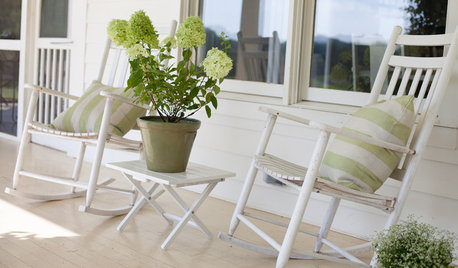
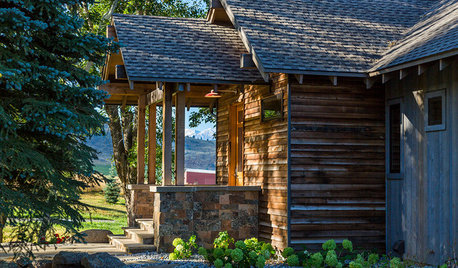

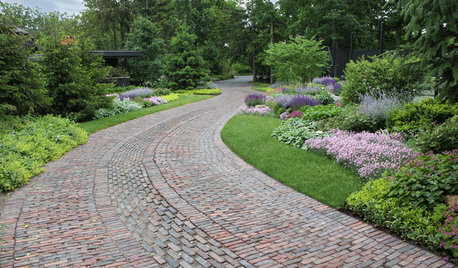

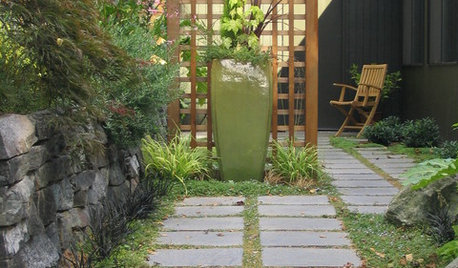
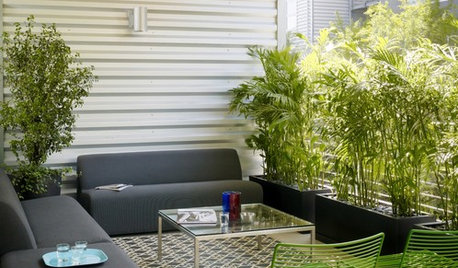
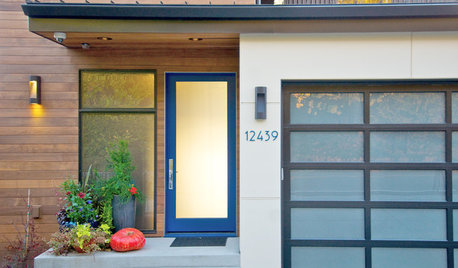
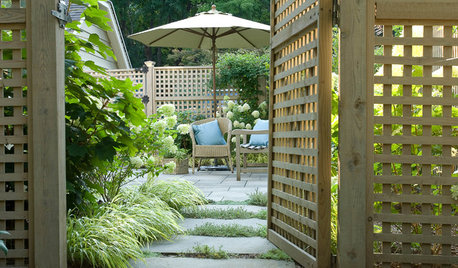










ken_adrian Adrian MI cold Z5